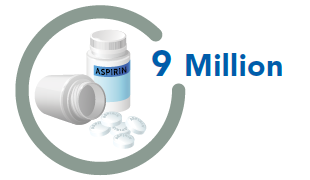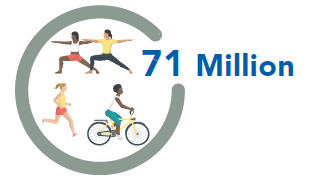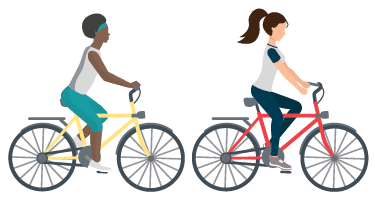Vital Signs: Preventing 1 Million Heart Attacks and Strokes
Middle-aged adults are being hard hit
Free Continuing Education (CE) on Vital Signs: Prevalence of Key Cardiovascular Disease Risk Factors for Million Hearts 2022 – United States, 2011-2016 (MMWR/Medscape) – available until November 15, 2019.
About 16 million heart attacks, strokes, and related heart-threatening events* could happen by 2022.
1 in 3 of these life-changing cardiovascular events happened in adults 35-64 years old in 2016.
80% of premature heart disease and strokes are preventable.
Heart attacks and strokes can be catastrophic, life-changing events that are all too common. Heart disease and stroke are preventable, yet they remain leading causes of death, disability, and healthcare spending in the US. Alarmingly, many of these events happen to adults ages 35-64—over 800,000 in 2016. Million Hearts® is a national initiative with a network of partners focused on preventing one million heart attacks, strokes, and other cardiovascular events by 2022. Coordinated actions by public health and healthcare professionals, communities, and healthcare systems can and will keep people healthy, optimize care, and improve outcomes within priority populations.
Healthcare professionals and systems can:
- Focus on the ABCS of heart health: Aspirin use when appropriate, Blood pressure control, Cholesterol management, and Smoking cessation.
- Take a team approach—use technology, standard processes, and the skills of everyone in the healthcare system to find and treat those at risk for heart disease and stroke.
- Make sure people who have had a heart attack or stroke get the care they need to recover well and reduce their risk of another event.
- Promote physical activity and healthy eating among their patients and employees.
* Deaths, hospitalizations, and emergency room visits due to heart attack, stroke, and other cardiovascular conditions like heart failure that could be prevented if Million Hearts 2022 actions are taken.


People not taking aspirin as recommended.

People with uncontrolled blood pressure.

Adults not using statins (cholesterol-lowering medicines) when indicated.

Adult smokers.

Adults who are physically inactive.
Populations more at risk.
- Americans aged 35-64 are less likely to use aspirin or statins (cholesterol-lowering medicines) when indicated, and only about half have their blood pressure under control.
- Blacks/African Americans are more likely than whites to develop high blood pressure—especially at earlier ages—and are less likely to have it under control.
- People with mental health and/or substance use disorders use tobacco more frequently.
- People who have already had one heart attack or stroke are at high risk for a second.
Source: Million Hearts® At-A-Glance, 2017

In 2016, about 775,000 hospitalizations and 75,000 deaths occurred in younger Americans, who are America’s workforce, parents, partners, and caregivers.
Getting to One Million
Everyone can take small steps to improve their own health, the health of their families and loved ones, patients, communities, and the heart health of our nation. We have to act now.

View large image and text description
Small changes in every state will have a big impact.
One million events could be prevented by 2022 if every state reduced these life-changing events by 6%.
While rates are higher in the Southeast and Midwest, small changes to improve heart health are needed in all states.
Million Hearts®: Everyone Can Make Small Changes that Matter.
The solution to this crisis is already in front of us. Small changes sustained over time will result in big improvements to the heart health of our nation. Everyone can take action.
Million Hearts® is working with more than 120 partners, all 50 states and the District of Columbia, and 20 federal agencies to:
Keep people healthy by making changes to environments in which people live, learn, work, and play to make it easier to make healthy choices.

HOW: Achieve a 20% reduction in sodium intake, tobacco use, and physical inactivity.

Communities making physical activity easier by creating walking and biking trails.

People adding 10 minutes of physical activity a day—like walking or gardening.
Optimize care so that those at risk for cardiovascular disease get services and skills needed to reduce the risk of having a heart attack or stroke.
- HOW: Achieve 80% performance in the ABCS, and 70% participation in cardiac rehabilitation.
- Insurers providing coverage for home blood pressure monitors.
- Clinicians using a standard treatment protocol for high blood pressure, cholesterol management, and tobacco cessation.

Improve outcomes for priority populations who suffer more from cardiovascular disease and where we know we can make an impact.
- HOW: Employers providing places and time for employees to walk during the workday.
- Behavioral health providers receiving training in smoking cessation and using it in their practice.

We’ve already begun.
Keeping People Healthy.
- Eskenazi Health in Indiana lowered sodium content of foods in all vending machines and cafeterias by 37% with their Choose Health Initiative.
Optimizing Care.
- Over 200 Federally Qualified Health Centers achieved more than 70% performance of the ABCS in 2016 earning a Million Hearts® badge.
Improving Outcomes for Priority Populations—People who have had a heart attack or stroke.
- Dartmouth-Hitchcock Medical Center in New Hampshire achieved 80% cardiac rehab enrollment through liaisons who identified eligible patients and connected them to programs.
The Federal Government is:
- Co-leading the Million Hearts® initiative (CDC and the Centers for Medicare & Medicaid Services) to prevent 1 million heart attacks and strokes by 2022. millionhearts.hhs.gov
- Helping improve the heart health of millions of Americans by investing in improving delivery of care, including rewarding clinicians for providing care we know works.
- Providing funding and support to all 50 states, the District of Columbia, municipalities, and tribal communities to ensure clinical and public health agencies are working together to prevent heart disease and stroke.
Healthcare Professionals & Systems Can:
- Focus on the ABCS of heart health: Aspirin use when appropriate, Blood pressure control, Cholesterol management, and Smoking cessation.
- Take a team approach—use technology, standard processes, and the skills of everyone in the healthcare system to find and treat those at risk for heart disease and stroke.
- Make sure people who have had a heart attack or stroke get the care they need to recover well and reduce their risk of another event.
- Promote physical activity and healthy eating among their patients and employees.
State And Local Health Departments Can:
- Use their state’s heart disease and stroke events data to drive Million Hearts® actions locally.
- Promote tobacco control interventions, smoke-free environments, and programs to help tobacco users quit.
- Work to improve heart-healthy nutrition and physical activity by promoting the use of healthy food service guidelines and making communities more walkable.
Employers Can:
- Make it easier for employees to get needed medicines, blood pressure monitors, and services by providing insurance coverage with no or low out-of-pocket costs.
- Provide on-site blood pressure monitoring and physical activity programs.
- Ensure smoke-free spaces and access to healthy food and beverages in vending machines and facilities.
Everyone Can:
- Start one heart healthy behavior today – eat a heart-healthy diet, get physically active, or quit smoking! Keep it going to keep your heart healthy now and later in life!
- Learn your heart age and take action to improve it. cdc.gov/heartdisease/heartage.htm
- If you don’t use tobacco, don’t start. If you do, seek help at 1-800-QUIT-NOW or www.smokefree.gov.

More information about Million Hearts® and tools you can use are available at millionhearts.hhs.gov.
Stories from people who have taken control of their blood pressure are available at https://www.nachc.org/taking-control-of-my-blood-pressure-patient-stories/.
Related Pages and Resources:
- Vital Signs –Preventing 1 Million Heart Attacks and Strokes [PODCAST – 1:15 minutes]
- Vital Signs –Preventing 1 Million Heart Attacks and Strokes [PSA – 0:60 seconds]
- Vital Signs Issue Details: Vital Signs: Prevalence of Key Cardiovascular Disease Risk Factors for Million Hearts 2022 — United States, 2011–2016, Morbidity and Mortality Weekly Report (MMWR)
- State-Level Variation in Nonfatal and Fatal Cardiovascular Events Targeted for Prevention by Million Hearts 2022, Morbidity and Mortality Weekly Report (MMWR)
- Million Hearts®
- Million Hearts® Partner Opportunities
- CDC’s Division for Heart Disease and Stroke Prevention
- CDC Heart Disease
- CDC Stroke
- Vital Signs: Preventing Stroke Deaths
- Best Practices for CVD Prevention
- Interactive Atlas for Heart Disease and Stroke
- Agency for Healthcare Research and Quality: Cardiovascular Disease Prevention
- About the Healthcare Cost and Utilization Project
- Healthcare Cost and Utilization Project Partners
- Community Strategies for Physical Activity
- Smoking and Tobacco Use
Information for Healthcare Professionals
- Actions Guides: Hypertension Control, Self-Measured Blood Pressure Monitoring, Tobacco Cessation, Medication Adherence
- Protocols: Hypertension Treatment, Tobacco Cessation, Cholesterol Management
- Hypertension Change Package
- Cardiac Rehabilitation Change Package
- Hypertension Control Champions
- Million Hearts® for Clinicians: Embed Resources on Your Website
Information for Everyone
- Taking Control of My Blood Pressure: Patient Stories
- Heart Age Calculator
- Physical Activity for a Healthy Weight
- Tips for Former Smokers®
Other Sites
- MedlinePlus: Heart Diseases
- MedlinePlus: Stroke
- American Heart Association
- American Stroke Association

